REMINISCENCES OF THE HIRAM WOODWARD HOME AND STUDIO
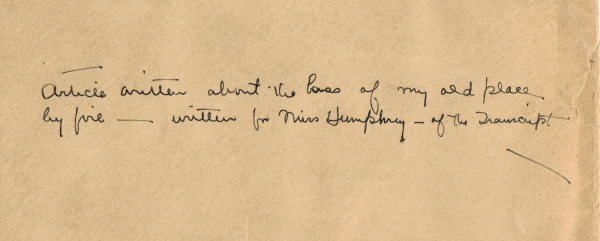
The envelope in which the essay below was found
"Article written about the loss of my old place
by fire - written for Miss Humphrey - of the Transcript."
On July 2, 1934, a fire destroyed the home and studio of Robert Strong Woodward known as the Hiram Woodward Place. A few months later, Miss Humphrey, a reporter for the North Adams Transcript asked Robert Strong Woodward to help her write an article by providing background information about his studio. RSW wrote the following article in the third person describing the ambience of his studio at the Hiram Woodward place.
Editors note:
At this time the Mohawk Trail was detoured away from Charlemont due to the construction of a new Scott's bridge over the Deerfield River between Buckland and East Charlemont. At this time traffic went up Route 112 past the Woodward estate, to Route 9 in Goshen and the Berkshire Trail
At this time the Mohawk Trail was detoured away from Charlemont due to the construction of a new Scott's bridge over the Deerfield River between Buckland and East Charlemont. At this time traffic went up Route 112 past the Woodward estate, to Route 9 in Goshen and the Berkshire Trail
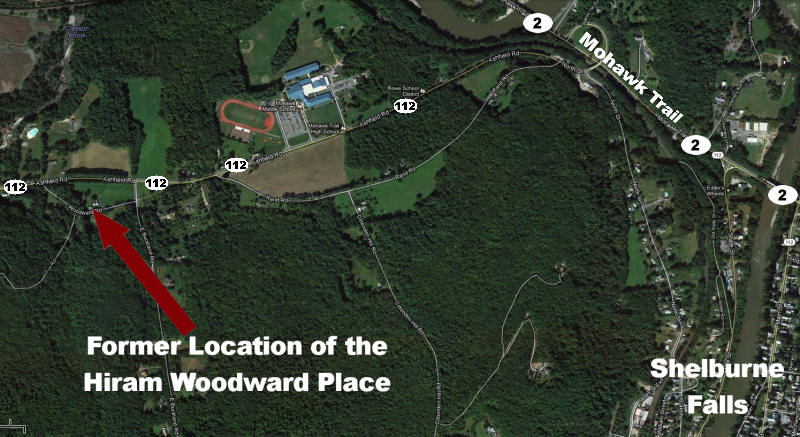
Map of Buckland Massachusetts showing location of Hiram Woodward Studio
Early in July the house and romantic studio of Robert Strong Woodward, a landscape painter of national prominence, fast coming to the fore in public eminence -- was struck by lightning and burned to the ground. The hundreds of daily motorists, speeding on the opened artery connecting the Mohawk and the Berskshire Trails, will no longer slacken their modern speed, to drive slowly past the white rambling cottage of many ells, with its blue blinds and its attached sheds of rare old boards of weathered red and green which extended on in true N. E. fashion at great length, to almost touch a friendly backyard orchard, with its background of steep dense pines.
No longer will the traveller slow and pause in admiration amounting to real affection - altho many for some time will still hesitate in surprise and sorrow - to find the landmark gone but in its place a level seeded patch of earth. Mr. Woodward, with his flair for neatness and with his unusual thot for his farmer neighbors, has spent what few dollars still remained to him - to level the gaunt chimneys and charred timbers - the tangled pipes and iron works, the burnt and blackened trees, which touch his very cottage walls - has filled the yawning cellar hole - with fertile seeded earth - reverting the loving labor of twenty five years, in rare construction and arrangement - back to the grassy mowing which surrounded it.

The Hiram Woodward House
To the stranger the white cottage and ells, were the house, while the long rambling buildings behind were but the adjoining sheds; to those fortunate enough to know Robert Strong Woodward personally, these "sheds" were the most rarely lovable and habitable quarters of the home. All was practical and livable and modern in its convenience - yet the entire interior of these so called "sheds", had gradually been lined with grayed and browned weathered boards, brought with patience and diligence out of old cellar holes and abandoned buildings, from all the surrounding hills and slopes of the country round about - all were cleverly built in with old hand wrought nails, culled with the boards a few at a time, - all cupboards, shelves, and closets - and they were legion - were made from fabulously wide boards of the old buttermilk red, or else from those that thru generations on some south wall, had been seasoned to a tawny orange or golden yellow.
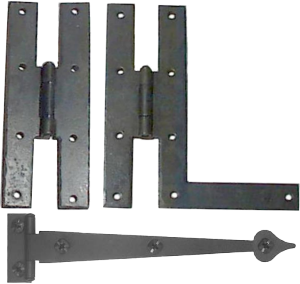
Sample H, HL, and Arrowhead strap hinges
Distinguished guests, as well as intimate friends were greeted from the wide carriage shed doors behind, which looked out upon the orchard and the pine - ushered in past long corridors of woodpiles, woodpiles fast growing famous, woodpiles composed of "body rock maple," with no round sticks - or even split ones with a bark edge. These woodpiles, flanking the outer walls of the studio room, which jutted into the heart of the sheds, were fitted stick by stick with exact surface and plane; but a short while before the fatal lightning reduced the towering tiers of butter colored maple, to black, charred ashes - a guest, passing them in awe had gasped that he considered them far more wonderful than the Woolworth Building.
The woodshed aisle led into the "back kitchen" - from this quaint room, with its brown rafters hung thick with bunches of dried herbs - catnip, pennyroyal, mint and thyme, and with countless old baskets, baskets mostly of colonial workmanship - but intermingled here and there with odd ones from foreign isles and kingdoms - one entered the kitchen proper - and thru another ancient gray door the studio itself.
In true democratic and cottage spirit, the kitchen held the huge mahogany dining table, - a piece admired and envied by students of antique furniture, with its center panel and two drop leaves of solid wood each twenty inches wide - four brass candlesticks guarded the center jar, where always a gay bouquet graced the room, while the walls were decked with choice Currier and Ives prints and with mirrors of the time of Washington.
From the kitchen, the living room opened directly - its center a plant bay window filled with brilliant geraniums and country blooms in the winter - but in the summer replaced with banks of maidenhair fern and royal fern, always potted with Mr. Woodward's own hands and arranged with astonishing grace. Outside the small lights of the fairy like window, a luxuriant grapevine filtered the sun, bore its blossoms, and matured its little green grapes into rich purple clusters - all against the window panes - and all as background for the banks of potted ferns - while in the center of this bower swam vermilion gold fish, in a square aquarium, which mirrored the dipping sprays of maiden-hair. Like his woodpiles, his old gray boards, his rare homespuns, which were scattered thruout the house, plus braided rugs - Mr. Woodward's south window of summer ferns, was fast growing famous.
To pass back thru the kitchen - into the back kitchen in order to reach the studio, one halts a moment in this latter room, in affection and wonder - in affection at the rare charming, natural "atmosphere" of the place, the core and heart of the house from which all the activities of an intricate house hold radiate, -- in wonder that such an aroma, such a flavor of the genuine old room, could have been achieved, by recent, even modern acquirement. The quaint little window panes of wavy glass - the house walls and casements of weathered wood, the handwrought ancient nails, the barn rafters hung with old herbs and quaint baskets - these alone, merely assembled to a pleasing unit, could not give this effect of rightness - of delicious atmosphere - even the fact that every exposed edge of the woodwork was a naturally grayed edge, or a browned edge, never sawed, and never stained - could have achieved this effect, nor the yellow ochre door to the little hanging corner cupboard, built of old red boards for the "tea things," nor the blue window sash, which looked right thru the center of the woodpile, and entirely framed with wood, gave an interesting glimpse into the studio room, rather than any light - none of these items alone gave this effect of ancient reality to this back kitchen - but rather the mere fact that the entire unit, the entire length of the rambling sheds and passage ways, was the natural expression of love and life of a man saturated and imbued with the spirit of old New England.
As he worked with his brush for perfection and spirited expression, down thru the years - Mr. Woodward, at the same time, gradually built up his home interiors, wall by wall, ceiling by ceiling - floor by floor - without a detail of effect, looking affected, without a detail of natural expression neglected. This rare atmosphere of the old, combined with every modern convenience for the smooth working of a large and intricate family and profession - has scarcely ever been equalled, scarcely ever even approached in this way.
Every electric wire and modern fixture in the establishment was artfully concealed behind old gray boards - every electric plug (and the house was rife with them, for the utmost convenience) was concealed behind bottles or jugs or old fabrics - there to use, but not there to be seen or to obtrude upon the blessed "atmosphere." It was not striving for effect - but a perfect lack of effect, which gave this unusual interior its compelling charm.
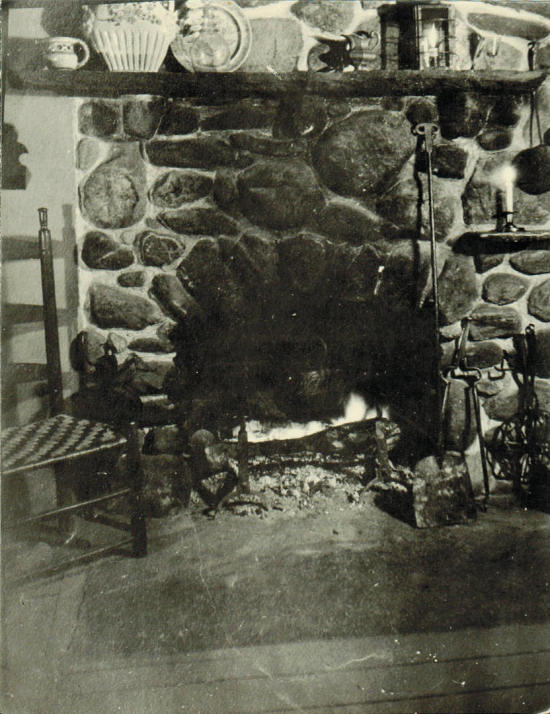
Stone Fireplace in the Hiram Woodward studio
At night the remarkable room partook of an unusual spirit, the graceful cherry table set for supper with prized old china and colored glass, the fire of huge logs glowing from the huge fireplace - the room lit entirely by a myriad of candles and colorful vigil lights. Many guests carry the picture of such an evening as among the most brilliant hours of their memory.
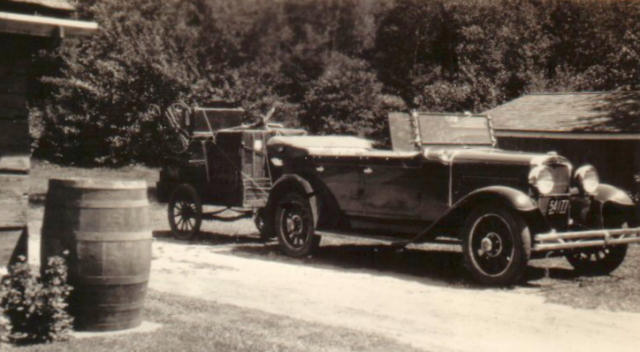
1929 Nash Advanced Six at Hiram Woodward Studio
Passing thru this raftered carriage shed, and out a wide red door with its strap hinges - one stepped on to the spacial porch - one more item of remarkable beauty - to the many visitors of the rambling dwelling. The exterior boards of these huge sheds, was built in generations past of wide weather beaten boards - one generation had painted their rough surface, an old red - another had coated them with green - the suns of years had blended them, shaded them into a subtle combination of the reds and greens and grays of time - until they boasted a bloom of color and character - which had grown to be the wonder of visiting architects.
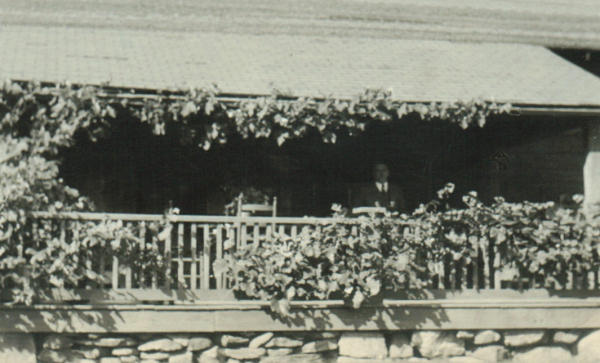
RSW looking out from the Hiram Woodward Studio porch with grapes
While to the south, thru the tangled grapevines, one looked into the green depths of a gnarled and ancient apple orchard, this too - backed with pines - Happy the guest who had Sunday morning breakfast in the sun of this porch under the grapes shielded from its direct light by Chinese umbrellas or Persian scarfs - the two wide openings thru these porch railings led to the lawns over stone steps of huge breadth - and once in the yard, one wandered about the entire estate to marvel at the stone work generously placed at every doorway and entrance.
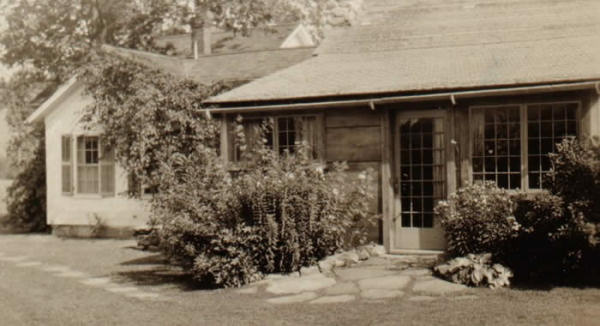
Some of the stone work in front of the Hiram Woodward Studio
This last entrance driveway was made over and completed, just this last May. Then all the front yard was solidly sodded about it - until the day after it was finished it looked as if it had naturally grown there for a hundred years! Just last May this final touch of perfection was added to the wonder of the stone work - to last but six weeks - before made useless and pointless - by a second's bolt of lightning! The artisan of the stone work, was Mr. Woodward's man Fabian - his attendant for many years - and as proud of his special handicraft - as a good workman should be - whenever abroad at their painting - or on any errands about the hills, they seldom returned, without some special prized stone in the car - from which all this special stonework was assembled. A natural trough stone lined with lichens, taken from an old wall in Buckland, carried away all the spill, from an eaves trough into the grass and ferns - rare stones of fitting shape, built the marvelously made stone wall about the barn yard, over which the driving-horse hung his free head - with friendly interest in the life about the yard.
A bit down the road, where two rushing brooks, both on Mr. W.'s property - converged to make an island, a camp place of astonishing stonework, had recently been built -- wonderful stone paving at the point where the two brooks diverged - a hospitable fireplace of natural stone, topped with a huge gray slab - and boasting a wide bob-shelf of stone to keep warm the first fried potatoes and the coffee, while the meat was broiled, a natural huge stone seat, curved like an armchair, was placed for Mr. Woodward's father who is blind, and a neighboring seat with its small stone table was thus for his mother. Big stone tables - for supplies and serving - and many stone seats - each with its small table shelf for hot coffee cup or plate - all in the shade of giant trees - all banked with fern and laurel - all moistened with the mist of foaming brooks made a camping site of stone almost too ideal to be believable.
Nearby a clear fresh pond, held back with a stone dam, and surrounded with pines and bushes - invited one to an afternoon swim - all quite in spirit of the old and dearly loved "swimming hole." Beyond this, across a mowing, an old cider mill, a quaint building of old weathered boards, had been lined and glassed and cupboarded into a rare retreat, for writing, or contemplation - sweetened with the music of a waterfall - cooled with the shade of dense woods. This old redeemed shop - with stone outdoor camp - and the shaded swimming pool - all of this in a secluded corner of wild woodland, totally secluded from road or dwelling - yet all within of moment's step of Mr. Woodward's house - made a complete unit of perfect living and expression -a combination of wild outdoor life, with efficient professional convenience in the home - scarcely equalled anywhere in the country.
The dream is over - one wakes to the raked and seeded earth, open to the sky and from where five weeks ago stood this rambling, fascinating and uniquely beautiful home and studio of Robert Strong Woodward. Travellers pause now, as they pass in sadness and sorrow - rather than in dynamic admiration.
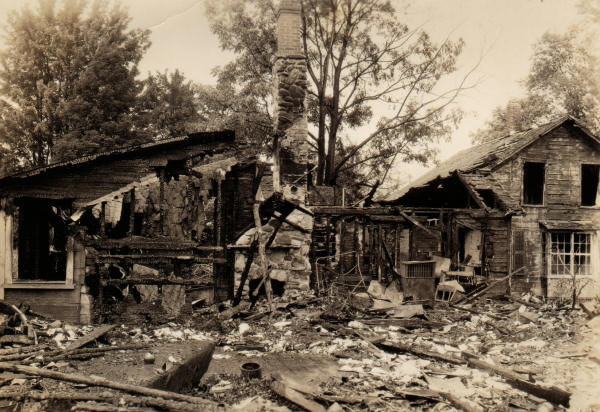
Hiram Woodward home and studio after the fire, 1934
But with his creative work intact - Robert Strong Woodward, in some unforeseen way, is to carry on. His dynamic work will live in all the winter exhibitions. His home, his studio, unusual in the world of creative expression - will live in the loving memory of unforgetting friends.
All that is left.
RSW
c.1934
MLP
2007

